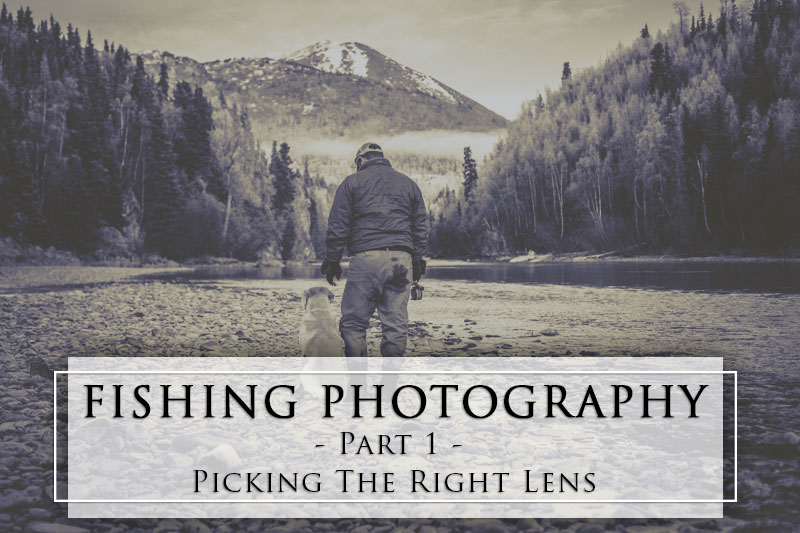Fishing Photography - Picking the Right Lens

Recently, I have had a few people ask me about lens selection in regard to fishing photography. More precisely, "What is the best lens I can get for the majority of my fishing situations?" While I wish it were a simpler question to answer, the fact is, each lens type has its own pros and cons. Every individual lens captures emotions differently, almost as if they have their own unique "personality." Here's my rundown:
Wide-Angle - The Hank Patterson of Lenses

I think we all have that fishing buddy who always brings the party. They always bring the beer, and are fun as hell regardless of the fishing conditions. They often get worked up over every fish, and are relentless in hassling you after you farm a monster. Simply put, a wide-angle lens is more or less the "Hank Patterson" of camera gear.
I find that images taken with a wide-angle lens have their own special kind of excitement to them. This lens style has a tendency to separate a subject from its background by maximizing the foreground and minimizing the size of the background. This will in turn add a lot of depth to your imagery. I find I most commonly use my wide-angle lens for grip and grin, close up action, and just all around energetic fishing situations.
While this style lens has provided me with a lot of great images, it also comes with it's own set of disadvantages. Unless you are shooting landscape images, where you are trying to shoot an entire scene, capturing your subject full frame requires the camera to be tight to the subject. Mountain ranges, trees, and other parts of your background tend to shrink in comparison to your subject. So if you are looking at capturing the details of the background, you may need to go with a longer style lens. When used properly though, a wide-angle lens can be one of your favorites, and is a must have in any photographers arsenal.
My personal favorite is the Cannon 20mm F/2.8 Ultrawide. It provides crisp, energetic images with minimal distortion, and won't completely break your bank at about $539.
Midrange - The "Decent at everything" guy.
I would put a midrange lens in the same category as another fishing buddy we all know. This angler knows a decent amount about every technique. Their fly boxes tend to be perfectly organized, their gear is in tip top shape, they fish with custom tied leaders, and really tend to focus on the details. A good midrange lens is very similar in its versatility and quality.
A staple if you are looking to highlight beauty and intricacies, a good mid-range lens, especially those with a low F-stop value, can create a variety of stunning images. As a bonus, the low F-stop value helps this lens in low light situations and allows for a very shallow depth of field. General portraits and detail-oriented images are my primary uses for this type of glass.
A good quality mid range lens has few downfalls. While it may not provide quite as much energy as a wide angle, is will fit the bill for most of your fishing photography.
Generally, I like my mid range lens to have as low of a f stop value as possible. My personal favorite is the Canon 50mm F/1.4. The nifty fifty as they call it will give you great image quality, and at around $399 is comparatively affordable.
Telephoto - The "Just happy to be out" guy
Telephoto lenses really can set the scene and give perspective to an image. Similar to that angler that is just happy to be out, they tend to sit way back and take it all in.
With a telephoto lens, the subject and its background will be brought together, giving your images a true sense of scale. As you can see above, the anglers and the background work hand in hand, allowing the viewer to feel the true scope of the canopy. A telephoto lens capable of zoom will allow you to jump in close and grab a tighter view when out at a distance. These situations comprise my primary uses of telephotos glass.
On the downside, a telephoto lens usually has a larger minimum focus distance, requiring you to be further away from your subject when shooting. This specifically comes into play when shooting in tight quarters, such as fishing out of a boat.
When out in the field I carry the Cannon EF 70-200mm F/2.8 lens. While this is my most expensive piece of glass, it offers a variety of options when it comes to shot selection. At about $1500, this one lens will definitely dent the pocketbook a bit, but as with all gear, you really do get what you pay for.
While owning multiple lenses can step your photography game up to the next level, only owning one should by no means be a limiting factor. Learn, play with, and explore your lens's strengths. Your images will become more compelling, and you will find yourself looking at your days on the water in a whole new perspective.
Lee Kuepper is professional guide now calling the Kenai River home. He is a co-owner of Alaska's Angling Addiction, chasing the Kenai's monster kings and fabled trout on a regular basis. He is also a member of Loop USA's prostaff and a Certified Fly Casting Instructor through the FFF.

